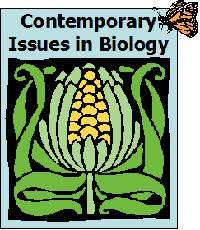
Week 2, Chapter 1 -- Freelance Writer Sample Answer
Course home | Weekly schedule | Announcements | Instructor Info | Desire2Learn | MasteringBiology® | Honor Code | FAQs | HELP!
 |
Week 2, Chapter 1 -- Freelance Writer Sample AnswerCourse home | Weekly schedule | Announcements | Instructor Info | Desire2Learn | MasteringBiology® | Honor Code | FAQs | HELP! |
I chose a brief story called “Coffee May Protect Against Colon Cancer”, which appeared at the following site: http://www.redorbit.com/news/science/20839/coffee_may_protect_against_colon_cancer/index.html. The study reports that a particular chemical in coffee, methylpyridinium, boosts the activity of certain enzymes that may prevent colon cancer. Unspecified animals, not humans, were the study’s subjects. The chemical, which is not found in raw coffee, appears in coffee beans as they are roasted.
I have chosen to create a Seinfeld episode:
Jerry’s neighbor Kramer watches the news on TV. He learns that a new study has shown that a particular chemical in coffee may help prevent colon cancer in laboratory animals. But the study didn’t really test the incidence of colon cancer; instead, the researchers found that the chemical from coffee boosted the activity of certain enzymes that may help prevent cancer.
Still, Kramer has a million-dollar idea. Since the chemical is present only in roasted (not green) coffee beans, he will find a way to roast coffee in his apartment and sell it as a cancer preventative. But before he can start selling it, he needs experimental evidence that it really does work. So he decides to test this hypothesis: Kramer’s coffee will enhance the activity of the cancer-preventing enzymes in humans.
To test his hypothesis, he enlists his four best friends – Jerry, George, Elaine, and Newman – as experimental subjects. Neither George nor Jerry really likes coffee, so Kramer assigns them as the control subjects – they will receive no coffee. Elaine and Newman will have to drink 6 cups a day of Kramer’s coffee. At the end of a week, Kramer will send stool samples from all four subjects to a biochemical lab, who will test them for enzyme activity.
Kramer believes everything he sees on TV, so he is sure that his experiment will show that Kramer roast really will work. So he decides not to wait on the results, and he starts roasting as much coffee as possible in his apartment. Pretty soon, Kramer’s coffee is spilling into the halls, and he is begging Jerry to let him store some in Jerry’s apartment. At first, nobody minds the smell, but as the coffee builds up, other tenants and the landlord are starting to complain. Kramer needs those experimental results!
Finally, the data come in – and Kramer is ecstatic when he sees that Elaine and Newman have much higher enzyme levels than Jerry and George. He even shows that the difference is statistically significant. So he goes ahead with his plan to sell the roasted coffee to local shops, and he enjoys great success for a short time, so he expands his operation to produce even more coffee.
Elaine tells her boyfriend, a biology professor at the State University of New York, about Kramer’s smashing success. He asks Kramer to show him the results of the experiment. At first he agrees that Kramer should go ahead, but then he thinks more about the experiment. Why is the sample size so small (only 2 people per treatment group), and why didn’t he assign his friends to the treatment groups at random? How do we know that Elaine and Newman didn’t have higher enzyme levels than Jerry and George before the experiment started? How do we know that any coffee wouldn’t have been just as effective as Kramer’s? Is elevated enzyme activity really associated with reduced cancer risk?
Reluctantly, the boyfriend reports the flawed experiment to the Food and Drug Administration. Kramer has to stop claiming that his coffee prevents cancer. No one buys the coffee anymore, but now Kramer is stuck with all this roasted coffee. Eventually he donates it to a homeless shelter and everyone is happy.
References:
HealthDayNews. 2003. Coffee may protect against colon cancer. http://www.redorbit.com/news/science/20839/coffee_may_protect_against_colon_cancer/index.html. Downloaded November 10, 2009.
Belk, C. and V. Borden. 2007. Biology: Science for Life, Second Edition. Pearson Prentice Hall. Upper Saddle River, NJ.
[538 words].
[Back to Freelance Writer Assignment]
[Sample assignment by Mariëlle Hoefnagels. Note that this sample assignment uses seven key words; only three are required. Also note that this particular article is older than what you are allowed to use for your own assignment.]
--------------------------------
Here's a sample response for this assignment:
Hi Mariëlle,
I looked at the study that you referenced in your post. I was really surpised to see how little information the story gave! To evaluate a study, it seems like you need some basic information about the study design, like the number of subjects, how long it lasted, what the treatments were, and what the researchers measured. This is frustrating to me because if I want to learn this basic information, I need to go back to the study itself, and that means plowing through a bunch of terminology that I definitely won't understand. Besides that, the headline didn't deliver what it promised at all! The story only mentioned studies with lab animals (what kind?) that showed that a certain compound boosted enzymes thought to protect against colon cancer.
Of course, that doesn't affect the quality of your story at all. It was really good!
Mariëlle
[129 words, and that's just for the "substantive" part (the first paragraph).]